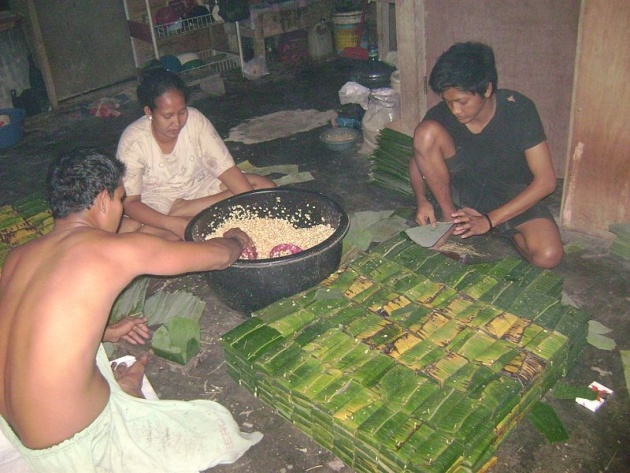Unlike other traditional soy foods are usually originate from China or Japan, tempeh originated from Indonesia. It is unclear when making tempe starts. However, this traditional food has been known since centuries ago, especially in the cultural order meal Java community, especially in Yogyakarta and Surakarta. In chapter 3 and chapter 12 manuscripts Fiber Centhini with setting Java 16th century (Fiber Centhini itself is written in the early 19th century) has found the word "tempe", for example, with the mention of the name of the dish jae Santen tempeh (a type of tempeh dishes with coconut milk) and kadhele srundengan tempeh. This and other available historical records indicate that it may initially be produced from black soybean tempeh, derived from the traditional rural communities of Java-may be developed in the area of Mataram, Central Java, and develops before the 16th century.
The word "tempe" probably derived from the ancient Javanese language. In the days of the ancient Javanese are white foods made from corn starch called tumpi. Tempe is also white fresh look has similarities with the tumpi food.
In addition there are references to Tempe from 1875 in a Javanese-Dutch dictionary. Other sources say that the manufacture of tempeh begins during the era of the Cultivation in Java. At the time, the Java community was forced to use the results of the yard, such as cassava , yams and soy, as a food source. In addition, there is also the notion that tempeh may be introduced by Chinese people who produce such foods, namely fermented soy koji1 using Aspergillus. Furthermore, the technique of making tempeh spread throughout Indonesia, in line with the deployment of the Java community migrate to all parts of the country

Indonesia is the country's largest soybean producer in the world and become the largest soybean markets in Asia. As many as 50% of Indonesian soy consumption is done in the form of soybean, 40% know, and 10% in the form of another product (such as tauco, ketchup, etc.). The average consumption of tempeh per person per year in Indonesia is currently thought to be about 6.45 kg.
In the days of the Japanese occupation of Indonesia, the prisoners of war who were fed tempe spared from dysentery and malnutrition. A number of studies published in the 1940s until the 1960s also concluded that many of the prisoners survived the Second World War because of tempe . According to Onghokham, protein-rich soybean has saved the health of the population of Indonesia is dense and relatively low income.
However, the name 'tempe' ever used in urban areas of Java, especially Central Java, to refer to something inferior. Terms such as 'mental tempe' or 'tempe class' is used to debase the sense that it is spoken of low quality because it's like tempeh. Sukarno, Indonesia's first president, often warned the Indonesian people by saying, "Do not become a nation of tempe." Only in the mid-1960s views on tempe is starting to change.
In the late 1960s and early 1970s there was a change in the manufacture of tempeh in Indonesia. plastic (polyethylene) began to replace banana leaves to wrap tempe, yeast-based flour (produced starting in 1976 by the Indonesian Institute of Sciences and is widely used by Indonesian Tofu Tempe Producers Cooperative, Coptic began to replace traditional laru, and soybeans began to replace local soybean imports. Tempeh production increased and the industry began to be modernized in the 1980s, partly thanks to the role of the Coptic stood on March 11, 1979 in Jakarta and in 1983 was comprised of more than 28,000 manufacturers tempeh and tofu.
Technical standards for the tempe has been set in the Indonesian National Standards and applicable since October 9, 2009 is ISO 3144: 2009. In these standards, soy tempe is defined as "the product obtained from the fermentation of soy beans by using Rhizopus sp., Compact solid form, white slightly grayish and distinctive smell tempe".
Tempe has the potential to be used against free radicals, which can slow aging and prevent degenerative diseases (atherosclerosis, coronary heart disease, diabetes mellitus, cancer, etc.). In addition Tempe also contain antibacterial substances that cause diarrhea, lowering blood cholesterol, preventing heart disease, hypertension, and others. [11]
Nutrient composition of tempe both levels of protein, fat, and carbohydrate did not change much compared to soybean. However, because of the digestive enzymes produced by fungi tempeh, protein, fats, and carbohydrates in Tempe to be more easily digested in the body than that found in soybeans. Therefore, tempeh is very good to be given to all age groups (from infants to the elderly), so it could be called the food of all ages.
Compared to soy, there are some things that benefit in Tempe. Chemically it can be seen from the increased levels of dissolved solids, dissolved nitrogen, free amino acids, free fatty acids, the value of digestibility, protein efficiency values, as well as the score of the protein.
Some research suggests that nutrients tempe more easily digested, absorbed, and utilized the body as compared to that in soybean. It has been demonstrated in infants and children under five malnutrition and chronic diarrhea.
With the provision of tempeh, weight gain will increase malnutrition and diarrhea are healed in a short time. Processing soybeans into tempeh will reduce levels of raffinosa and stakiosa, which is a compound causing symptoms of flatulence (bloated belly).
High nutritional quality allows the addition of tempeh tempeh to improve the quality of cereals and tubers. Daily food dish consisting of rice, corn, or Tiwul will increase the quality of nutrition when added tempeh.
A piece of fried tempe (50 grams) is sufficient to improve the nutritional quality of 200 g rice. Foodstuffs-tempeh mixture of rice, corn-soybean, cassava-tempe, the ratio of 7: 3, has been good enough to be given to children under five.

Fatty acid
During the fermentation process, there is a tendency for an increase in the degree of unsaturation of the fat. Thus, polyunsaturated fatty acids (polyunsaturated fatty acids, PUFAs) increased in number.
In the process it palmitic acid and linoleic acid decreased slightly, whereas the increase occurred in oleic acid and linolenic acid (linolenic acid is not present in soy). Unsaturated fatty acids have a lowering effect on serum cholesterol content, so it can neutralize the negative effects of sterols in the body.
Vitamin
Two groups of vitamins contained in Tempe, which is water soluble (vitamin B complex) and fat soluble (vitamins A, D, E, and K). Tempe is a source of vitamin B with huge potential. Types of vitamins contained in Tempe, including vitamin B1 (thiamine), B2 (riboflavin), pantothenic acid, nicotinic acid (niacin), vitamin B6 (pyridoxine) and B12 (cyanocobalamin).
Vitamin B12 is commonly found in animal products and are not found in plant foods (vegetables, fruits, and grains), but tempeh tempeh contain vitamin B12 so as to be the only potential source of vitamins from vegetable foodstuffs. The increase in levels of vitamin B12 is most striking in the manufacture of tempeh; vitamin B12 activity increased to 33 times during the fermentation of soybeans, up about 8-47 times riboflavin, pyridoxine 4-14 times, niacin 2-5 times, 2-3 times biotin, folic acid 4-5 times, and pantothenic acid 2 times fold. This vitamin is not produced by molds tempeh, but by bacterial contaminants such as Klebsiella pneumoniae and Citrobacter freundii.
Levels of vitamin B12 in tempeh ranged from 1.5 to 6.3 micrograms per 100 grams of dried tempeh. This amount has been able to meet the needs of a person per day of vitamin B12. With the presence of vitamin B12 in tempeh, vegetarians need not feel concerned about the shortage of vitamin B12, as long as they involve the tempeh in the daily menu.
Mineral
Tempe contains macro and micro minerals in sufficient quantities. Total minerals iron, copper, and zinc are respectively 9.39; 2.87; and 8.05 mg per 100 g tempeh.
Tempeh molds can produce phytase enzyme which will describe the phytic acid (which binds several minerals) to phosphorus and inositol. With the disintegration of phytic acid, certain minerals (like iron, calcium, magnesium, and zinc) to be more available to be utilized the body.
Antioxidants
Inside Tempe antioxidant also found a substance in the form of isoflavones. Like vitamins C, E, and carotenoids, isoflavones also an antioxidant that is needed body to stop the reaction of free radical formation.
In soybeans there are three types of isoflavones, namely daidzein, glisitein, and genistein. In Tempe, in addition to the three types of isoflavones are also contained an antioxidant factor II (6,7,4-trihydroxy isoflavone), which has the most powerful antioxidant properties than the isoflavones in soy. These antioxidants are synthesized during the fermentation process of soybeans into tempeh by bacteria Micrococcus luteus and Coreyne bacterium.
Aging (aging) can be inhibited when the food consumed daily contains enough antioxidants. Because tempeh is a good source of antioxidants, consumption of sufficient amounts regularly can help prevent premature aging.
Research conducted at the University of North Carolina, USA, found that genestein and phytoestrogens found in soybean was able to prevent prostate and breast cancer.



